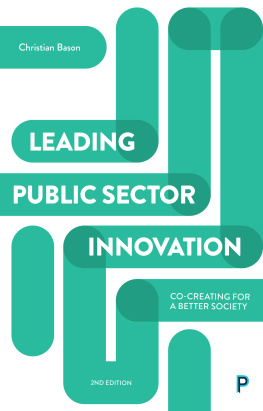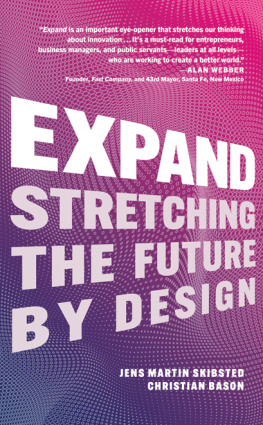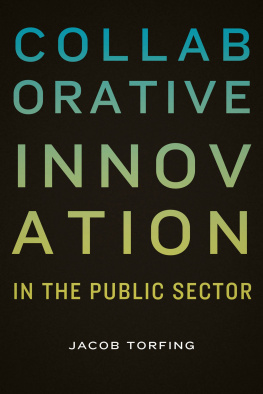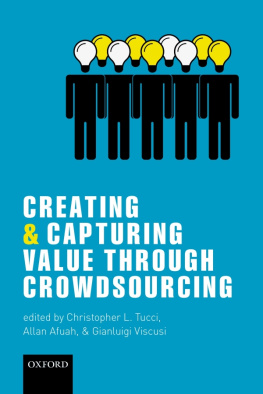
First edition published in 2010.
Second edition published in Great Britain in 2018 by
Policy Press University of Bristol 1-9 Old Park Hill Bristol BS2 8BB UK Tel +44 (0)117 954 5940 e-mail
North American office: Policy Press c/o The University of Chicago Press 1427 East 60th Street Chicago, IL 60637, USA t: +1 773 702 7700 f: +1 773-702-9756 e:
Policy Press 2018
British Library Cataloguing in Publication Data
A catalogue record for this book is available from the British Library
Library of Congress Cataloging-in-Publication Data
A catalog record for this book has been requested
978-1-4473-33624-2 paperback
978-1-4473-33625-9 ePdf
978-1-4473-33627-3 ePub
978-1-4473-33626-6 Mobi
The right of Christian Bason to be identified as author of this work has been asserted by him in accordance with the Copyright, Designs and Patents Act 1988.
All rights reserved: no part of this publication may be reproduced, stored in a retrieval system, or transmitted in any form or by any means, electronic, mechanical, photocopying, recording, or otherwise without the prior permission of Policy Press.
The statements and opinions contained within this publication are solely those of the author and not of the University of Bristol or Policy Press. The University of Bristol and Policy Press disclaim responsibility for any injury to persons or property resulting from any material published in this publication.
Policy Press works to counter discrimination on grounds of gender, race, disability, age and sexuality.
Cover design by My Buemann, Danish Design Centre
Front cover image: My Buemann, Danish Design Centre
Readers Guide
This book has been optimised for PDA.
Tables may have been presented to accommodate this devices limitations.
Image presentation is limited by this devices limitations.
For Malene and our children,
Christopher, Julia and Lillian
Contents
This book could not have been written without the energy, efforts and dedication of my colleagues at MindLab and in the three national government departments we are part of: the ministries of Economic and Business Affairs, Taxation and Employment. Key insights and a number of the case examples in the book are drawn from our experiences there. Special thanks to Niels Hansen, who prepared our internal evaluation research, to Jakob Schjrring, and to PhD fellows Jesper Christiansen and Nina Holm Vohnsen, who have provided much of the input to the chapter on citizen-centred research. I am indebted to my former colleague and co-author Sune Knudsen for showing me the value of design thinking, and to Kit Lykketoft for managing MindLab while I wrote much of the book. Helle Vibeke Carstensen deserves a special mention for constructive critique from the particular vantage point of tax administration.
The wider national and international network of public innovators, scholars and government officials that I have drawn on and who have contributed in one way or another to the book are numerous. I think most of you know who you are, and will find your work in some way reflected in the following pages. However, I want to especially mention David Hunter, Martin Stewart-Weeks, David Albury, Geoff Mulgan, Valerie Hannon, John Bessant, Sophia Parker, Brenton Caffin, Tonya Surman and Justine Munro for exposing me further to developments in the UK, US, Australia and New Zealand, for inspiring conversations and for concrete inputs to the work.
Leading Public Sector Innovation also draws on my earlier work on innovation in government, including a research project that I headed at the consultancy Rambll and two books I wrote on the topic in Danish, published in 2007 and 2009. Some sections are directly or indirectly inspired from these books.
During my writing, I have noted that innovation in government is gaining momentum. From being an interest mainly of academics a few years ago, public sector innovation is quickly becoming a focus of public top executives and politicians and, more importantly, of the middle managers and project leaders who can get innovation off the ground. From the UK, France and Denmark to Australia, New Zealand and the US, public sector innovation is shifting from a what to a how. Perhaps it is just a temporary trend. Or perhaps it is a recognition that in times of turbulent change, just doing more of the same wont be even close to good enough. I choose to believe it is the latter.
Christian Bason
Copenhagen, May 2010
When my editors at Policy Press asked if I was open to publishing a second edition of the book you are holding, I hesitated briefly, but then thought Why not? Its about time. Since I wrote Leading Public Sector Innovation in late 2009 and early 2010, the idea and practice of innovation in the public sector has grown immensely, in both qualitative and quantitative terms.
Qualitatively, we have gained a much better and deeper understanding of what it takes to work systematically with innovation in public organisations. Not only have a range of governments including those mentioned in my original preface made significant advances in innovation practice. Some, ranging from the Australian government to Chilean public services and the Norwegian health sector, have used the books framework directly in their innovation strategies.
A range of international organisations, such as the European Union (EU), the Organisation for Economic Co-operation and Development (OECD) and leading civic organisations like Bloomberg Philanthropies and Nesta, the United Kingdom (UK) innovation foundation, have developed research, strategies and policies to advance our understanding and practice of innovation work for public purpose. Additionally, careful academic research has been carried out, addressing themes like innovation management in government or the rise of social and public innovation labs.
Quantitatively, many more actors have joined the field, ranging from cities and local government administrations to national and international bodies, and the past decade has seen a vast expansion in the adoption of approaches to create more innovative services and policies. This has in turn contributed a wider array of empirical cases and evidence to study constituting a mostly positive and reinforcing cycle of change.
So, this second edition of Leading Public Sector Innovation necessarily entails a bit of stock taking. While respecting its foundation, the text has been updated with additional cases, examples, data and two all-new chapters on innovation labs and design leadership. The new edition also reflects my own growing experience in working with innovation in government. After writing the first edition I worked another four years leading the Danish governments innovation team, MindLab, before accepting the role of CEO of the Danish Design Centre, a publicly funded institution committed to advancing the value of design for business and society. The latter position has proved to be a substantial learning opportunity, as I have attempted to practise many of this books preachings in our work.
Since the first edition, I have also concluded a comprehensive PhD research project among public managers who have used design approaches in their innovation work. My findings have also been published by Policy Press in a new book titled Leading Public Design: Discovering the Next Governance Model . That book is essentially a companion to the one you are holding now, as it expands widely on issues of design, leadership and the future of public governance.














